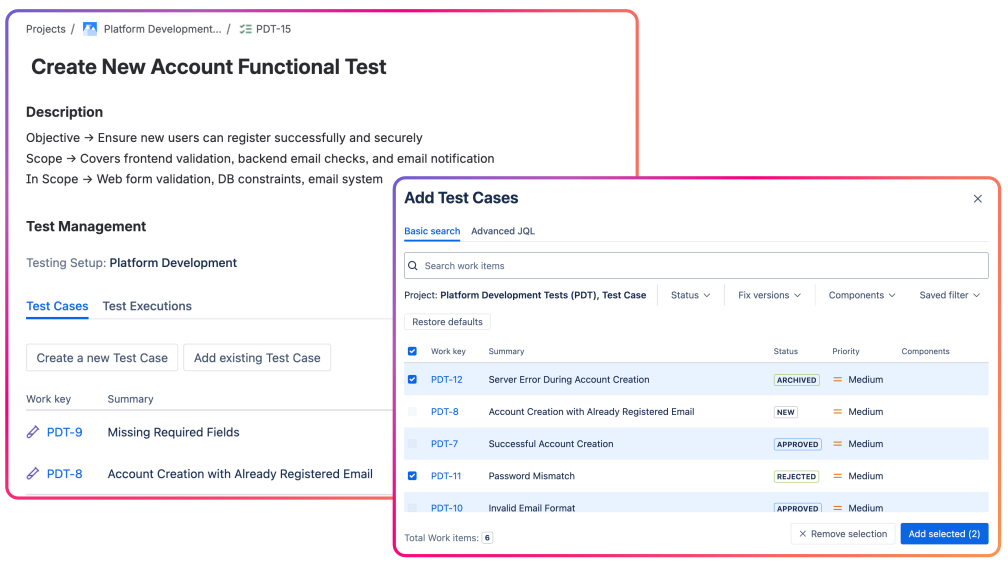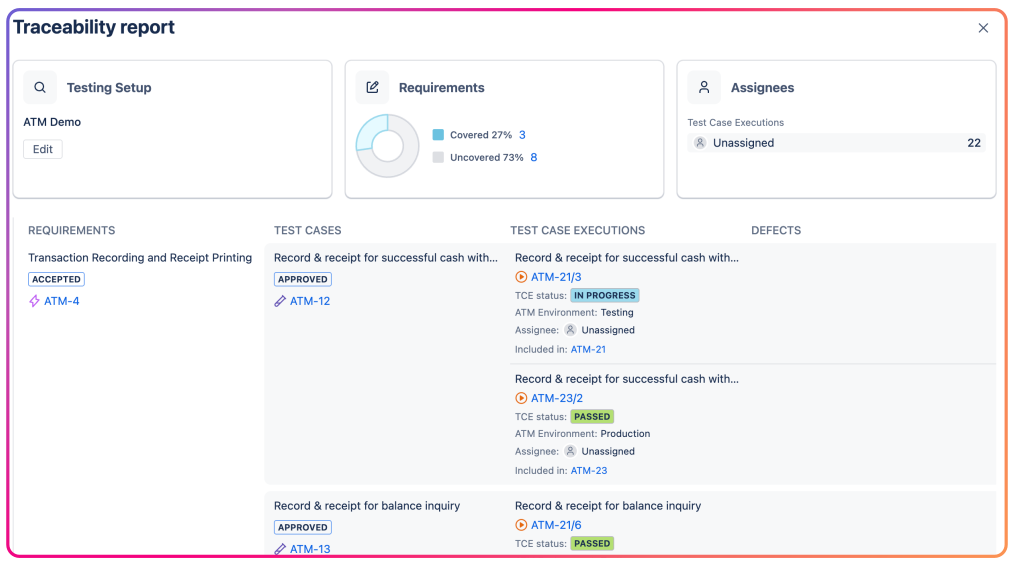A solid test plan remains one of the cornerstones of effective quality assurance - even in 2025, when agile methods, automation and AI-assisted testing have become standard. Yet, many QA teams still treat the test plan as a formality. In reality, it’s your roadmap for delivering reliable software and helping teams stay aligned. That’s how you identify risks early and communicate expectations clearly as well.
This article walks you through what a good test plan looks like today, how it evolved with agile practices and how you can build one using Appsvio Test Management (ATM) for Jira.
What is a Test Plan?
A test plan is a structured document that describes the scope, objectives and approach of the testing activities. It also involves a schedule of the testing efforts. According to the ISTQB glossary, it defines what will be tested, how, when and by whom.
A well-written test plan provides visibility, even in Agile and DevOps environments with fast iteration cycles. Overall, it ensures that QA teams, developers and business stakeholders share the same understanding of what “done” looks like. Think of it as a communication bridge, not bureaucracy.
Key Elements of a Modern Test Plan
While the format has become leaner and more integrated into tools like Jira, the core components defined by standards bodies remain vital. These essential elements coupled with a test plan template, transform it from a checklist into an actionable strategy:
- Test objectives – Why are we testing? What outcomes are expected?
- Scope and features to be tested – Define which areas are in and out of scope.
- Test strategy – Specify methodologies: manual, automated, exploratory or API testing.
- Test environment – Describe configurations, tools and datasets.
- Test schedule and milestones – When specific phases (planning, execution, reporting) will happen.
- Roles and responsibilities – Assign clear ownership for test execution and reporting.
- Risks and mitigation – Identify potential blockers early.
Your test plan template doesn’t need to be static. Above all, it should evolve with your project, as well as your testing process does. This adaptability is non-negotiable in fast-paced delivery models, ensuring your plan stays relevant from sprint one through to release. When you house your plan in a dynamic tool, your team can seamlessly make real-time adjustments as priorities or requirements inevitably shift.
Agile Method in Testing: Flexibility with Structure
It’s important to realize that Agile testing embraces adaptability. Instead of one massive, fixed document, modern teams create dynamic plans that evolve sprint by sprint. Using Appsvio Test Management (ATM), you can design agile-friendly test plans directly inside Jira - linked to user stories, test cases, and issues.
This approach ensures that QA managers and testers can track changes in real time while maintaining traceability. The agile method in testing doesn’t remove planning. It just makes planning smarter, contextual and iterative.
How to Write Your Test Plan in Jira
Here’s how you can write and maintain a test plan directly within Jira using ATM. This approach transforms your planning process from static documentation into a dynamic management hub:
- Create your Test Plan work item
In ATM, test plans are native Jira work items. This means your plan instantly inherits Jira’s workflow capabilities - you can assign owners (for example a Test Manager), comment, track status and apply standard Jira permissions just like any other task.

Test plans bring related test cases together - ensuring full coverage of functionality,
visibility into progress, and consistency across validation efforts.
Easily connect relevant test cases, epics, user stories and defects to your plan. This provides full end-to-end traceability and allows you to instantly visualize requirements coverage across your entire project.
- Leverage Cross-Project Functionality
ATM supports cross-project testing, allowing a single Test Plan to pull and reuse Test Cases from other projects. This is essential for managing testing in large, interconnected enterprise environments.
- Ensure Consistency with Templates and Versioning
Use predefined templates to save time and maintain consistency across different releases. Crucially, ATM’s Test Steps Versioning ensures that when you update a Test Case, previous Test Execution results remain linked to the exact version of the steps that were run. That’s how you can easily maintain an auditable record.
- Generate Reports Automatically
Move beyond manual reporting. With one click, generate comprehensive Test Execution reports and Traceability matrices that provide real-time visibility into quality metrics and overall progress. This makes Appsvio Test Management more than just a Jira software testing tool. It actually becomes your single, enterprise-ready source of truth for test planning and execution.

A traceability report connects requirements, test cases, executions, and defects
- giving teams full visibility into coverage and progress across the testing process.
Why Test Management Tools Matter
in 2025
Despite the rise of automation and AI, test management remains human-driven. A good Jira test management tool ensures that testing doesn’t become siloed or disconnected from the product lifecycle. With ATM, all your testing data - from test cases to execution results - stays inside Jira, improving visibility and reducing context switching. You don’t need external spreadsheets or outdated documentation. Everything lives where your development already happens.
Common Pitfalls to Avoid
The easiest way to sabotage your quality efforts is to treat the test plan as a compliance exercise. In the age of rapid releases, these common pitfalls can quickly slow your team down and introduce critical blind spots:
- Overcomplicating the structure - clarity beats verbosity
- Copying old templates without review
- Forgetting non-functional testing (performance, security, accessibility)
- Treating the plan as a static artifact instead of a living document
A test plan template should support you, not slow you down. Modern tools like ATM help teams adjust it as the product evolves. By using a centralized, native Jira tool, you ensure that every update to the plan immediately reflects in your linked test executions. Additionally, you prevent the costly disconnect between documentation and reality. This approach empowers your team to maintain quality control without getting bogged down in outdated paperwork.
The New Balance
In 2025, writing a good test plan is about finding balance, where structure meets agility. Whether you manage enterprise software testing or run smaller agile teams, a consistent, accessible test plan helps everyone move faster with confidence.
If you’re ready to modernize your testing process, try Appsvio Test Management for Jira. It’s a purpose-built solution that brings planning, execution, and reporting together in one place - so your team can focus on delivering quality, not paperwork.